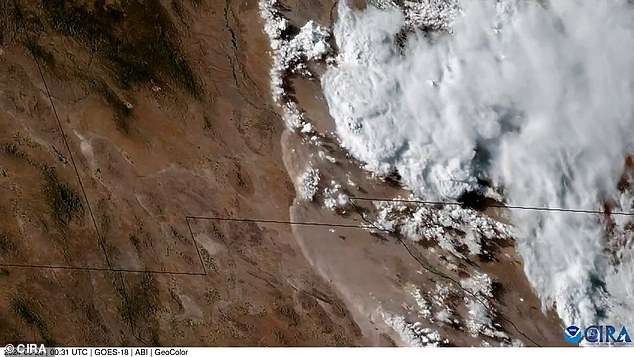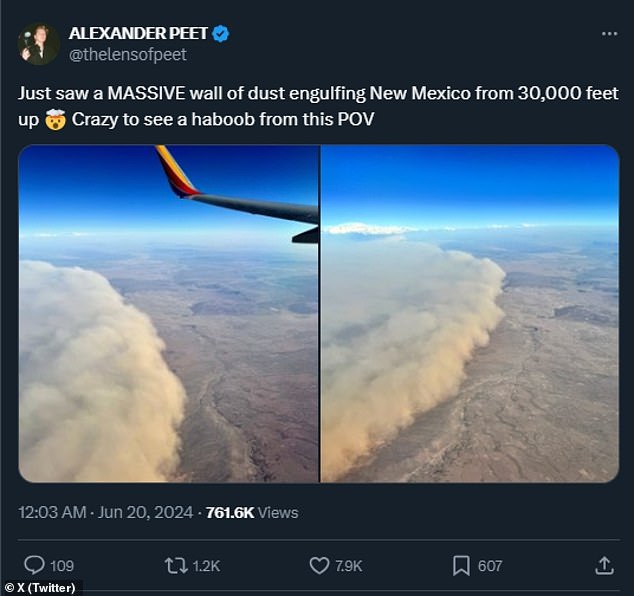A gigantic dust storm more than 200 miles long is blowing across the US and is being observed from SPACE
A destructive and epically proportioned dust storm, more than 200 miles (320 km) long, tore through New Mexico on Wednesday, sending up clouds of debris visible from space.
The extreme storm, which also extended into northern Mexico, hospitalized 18 motorists after rolling, opaque clouds caused multiple accidents on Interstate 25.
The storm’s massive dust wave was captured in vivid color from a satellite jointly operated by the National Oceanic and Atmospheric Administration and Colorado State’s Cooperative Institute for Research in the Atmosphere (CIRA).
“Less than half a mile visibility southeast of Deming,” the National Weather Service office in El Paso warned residents near the state’s southern border as the storm continued.
High-speed winds of up to 90 miles per hour whipped through southern parts of the state, while the Albuquerque area was left with piles of icy hail from the storm — which also caused mudslides and flooding near New Mexico’s Sierra Blanca Mountains .
A massive and destructive dust storm – more than 200 miles long – tore through New Mexico on Wednesday, sending up clouds of debris visible from space – via satellite images managed by Colorado State’s Cooperative Institute for Research in the Atmosphere (above)

High-speed winds of up to 90 miles per hour whipped through parts of southern New Mexico, while the Albuquerque area was left with piles of icy hail from the storm – which also caused mudslides and flooding near the Sierra Blanca Mountains of the stands.
This type of dust storm – caused by a shift in air pressure in the wake of a severe thunderstorm – is technically known to meteorologists as a “haboob,” from the Arabic word for “explosion.”
In the lead-up to a developing thunderstorm, wind rushes toward the cloud formation from all directions, but the curse breaks once the storm’s heavy rains begin to flow.
Soon, an intense “crash,” a cold, dense outflow of air, loose soil, sand, dust, and debris pushes upward as it rushes out of the ongoing thunderstorm.
The resulting ‘haboob’ dust storm is capable of shooting these particles up to 1,500 meters into the air.
And the subsequent wall of small particles can not only obscure vision, but can also lead to health problems, as the particles contain a mixture of mold, pollutants, chemicals and more.
Haboobs can occur anywhere in the United States, but are most common in the Southwest.
They are also common in the Middle East and, in recent years, Australia – thanks to increasingly drier conditions on the continent due to global climate change.
But the New Mexico haboob surprised scientists on Wednesday with its size and strength, according to the Washington Postand the citizens were equally impressed.

One airline passenger photographed the advancing dust wall from 10,000 feet above the state, posting on social media site
One airline passenger photographed the advancing dust wall from 35,000 feet above the state and posted on social media: “Crazy to see a haboob from this POV.”
UCLA climate scientist Dr. Daniel Swain attributed the storm’s ferocity to the climate change-intensified hurricane and tropical storm season, which began this month.
‘Residual moisture and ‘spin’ (vorticity) from former Tropical Storm Alberto have brought a litany of unusual weather (early season rain, severe thunderstorms, flash flooding and a major dust storm/haboob) to TX, NM, AZ and northern MX for the past three days, ‘Dr. Swain explained Friday.
Dr. Jonathan Overpeck, a climate change expert who won the 2007 Nobel Peace Prize for his role in leading the United Nations’ IPCC analysis of global warming, agreed, but added a terrible prediction.
“As climate change dries out the American Southwest,” says Dr. Overpeck wrote‘major dust storms will become more common.’
